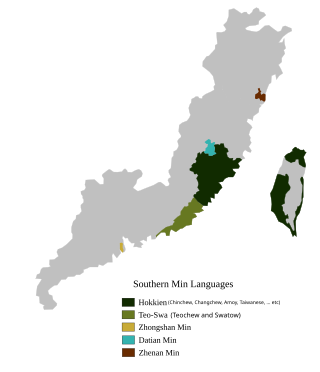
Back هاکین دیلی AZB Ho̍h-ló-oē CEB Hokkien Czech Hokkien German Hokla lingvo Esperanto Hokkien Spanish هاکین Persian Bahasa Hokkien ID Hokkien ILO Dialetti hokkien Italian
| Hokkien | |
|---|---|
| Min Nan, Fukien, Amoy | |
 Koa-á books featuring Hokkien written in Chinese characters | |
| Region | China,[a] Taiwan,[b] Singapore, Malaysia,[c] Philippines,[d] Indonesia,[e] Myanmar,[f] Cambodia,[g] Hong Kong,[h] Vietnam,[i] Thailand,[j] Brunei[k] |
| Ethnicity | Hokkien / Hoklo people |
Native speakers | more than 47 million (est.)[m][1] |
Early forms | |
| Dialects |
|
| |
| Official status | |
Official language in | |
| Regulated by | Taiwan Ministry of Education |
| Language codes | |
| ISO 639-3 | nan for Southern Min (hbl is proposed[11]) |
| Glottolog | hokk1242 |
 Distribution of Southern Min languages, with Hokkien in dark green | |
 Polities by number of Hokkien speakers
≥1,000,000
≥500,000
≥100,000
≥50,000
Significant minority populations | |
| Hokkien | |||||||||||||||||||||||||||||||||||||||
|---|---|---|---|---|---|---|---|---|---|---|---|---|---|---|---|---|---|---|---|---|---|---|---|---|---|---|---|---|---|---|---|---|---|---|---|---|---|---|---|
| Traditional Chinese | 福建話 | ||||||||||||||||||||||||||||||||||||||
| Simplified Chinese | 福建话 | ||||||||||||||||||||||||||||||||||||||
| Hokkien POJ | Hok-kiàn-ōe / Hok-kiàn-ōa | ||||||||||||||||||||||||||||||||||||||
| |||||||||||||||||||||||||||||||||||||||
| Southern Min / Min Nan | |||||||||||||||||||||||||||||||||||||||
| Traditional Chinese | 閩南話/閩南語 | ||||||||||||||||||||||||||||||||||||||
| Simplified Chinese | 闽南话/闽南语 | ||||||||||||||||||||||||||||||||||||||
| Hokkien POJ | Bân-lâm-ōe / Bân-lâm-ōa / Bân-lâm-gú / Bân-lâm-gí / Bân-lâm-gír | ||||||||||||||||||||||||||||||||||||||
| |||||||||||||||||||||||||||||||||||||||
| Hoklo | |||||||||||||||||||||||||||||||||||||||
| Traditional Chinese | 福佬話 | ||||||||||||||||||||||||||||||||||||||
| Simplified Chinese | 福佬话 | ||||||||||||||||||||||||||||||||||||||
| Hokkien POJ | Ho̍h-ló-ōe / Hô-ló-ōe / Hō-ló-ōe | ||||||||||||||||||||||||||||||||||||||
| |||||||||||||||||||||||||||||||||||||||
| Lanlang | |||||||||||||||||||||||||||||||||||||||
| Traditional Chinese | 咱人話/咱儂話 | ||||||||||||||||||||||||||||||||||||||
| Simplified Chinese | 咱人话/咱侬话 | ||||||||||||||||||||||||||||||||||||||
| Hokkien POJ | Lán-lâng-ōe / Lán-nâng-ōe / Nán-nâng-ōe | ||||||||||||||||||||||||||||||||||||||
| |||||||||||||||||||||||||||||||||||||||
Hokkien (/ˈhɒkiɛn/ HOK-ee-en, US also /ˈhoʊkiɛn/ HOH-kee-en)[12] is a variety of the Southern Min languages, native to and originating from the Minnan region, in the southeastern part of Fujian in southeastern mainland China. It is also referred to as Quanzhang (Chinese: 泉漳; pinyin: Quánzhāng), from the first characters of the urban centers of Quanzhou and Zhangzhou.
Taiwanese Hokkien is one of the national languages in Taiwan. Hokkien is also widely spoken within the overseas Chinese diaspora in Singapore, Malaysia, the Philippines, Indonesia, Cambodia, Myanmar, Hong Kong, Thailand, Brunei, Vietnam elsewhere across the world. Mutual intelligibility between Hokkien dialects varies, but they are still held together by ethnolinguistic identity.[6]
In maritime Southeast Asia, Hokkien historically served as the lingua franca amongst overseas Chinese communities of all dialects and subgroups, and it remains today as the most spoken variety of Chinese in the region, including in Singapore, Malaysia, Philippines, Indonesia. This applied to a lesser extent to mainland Southeast Asia.[13] The Betawi Malay language, spoken by some five million people in and around the Indonesian capital Jakarta, includes numerous Hokkien loanwords due to the significant influence of the Chinese Indonesian diaspora, most of whom are of Hokkien ancestry and origin. Hokkien Kelantan in northern Malaya of Malaysia and Hokaglish spoken sporadically across the Philippines, especially Metro Manila are also mixed languages with Hokkien as the base lexifier.
Cite error: There are <ref group=lower-alpha> tags or {{efn}} templates on this page, but the references will not show without a {{reflist|group=lower-alpha}} template or {{notelist}} template (see the help page).
- ^ a b Hokkien at Ethnologue (23rd ed., 2020)

- ^ Ethnologue. "Languages of Singapore – Ethnologue 2017". Retrieved 14 July 2017.
- ^ Mei, Tsu-lin (1970), "Tones and prosody in Middle Chinese and the origin of the rising tone", Harvard Journal of Asiatic Studies, 30: 86–110, doi:10.2307/2718766, JSTOR 2718766
- ^ Pulleyblank, Edwin G. (1984), Middle Chinese: A study in Historical Phonology, Vancouver: University of British Columbia Press, p. 3, ISBN 978-0-7748-0192-8
- ^ Hammarström, Harald; Forkel, Robert; Haspelmath, Martin; Bank, Sebastian (10 July 2023). "Glottolog 4.8 - Min". Glottolog. Leipzig: Max Planck Institute for Evolutionary Anthropology. doi:10.5281/zenodo.7398962. Archived from the original on 13 October 2023. Retrieved 13 October 2023.
- ^ a b c d e f g h i j k l "Reclassifying ISO 639-3 [nan]: An Empirical Approach to Mutual Intelligibility and Ethnolinguistic Distinctions" (PDF). Archived from the original (PDF) on 19 September 2021.
- ^ "Draft National Language Development Act Clears Legislative Floor". Focus Taiwan. CNA. 25 December 2018.
- ^ 立院三讀《國家語言發展法》 公廣集團可設台語電視台. Apple News (in Chinese). 25 December 2018. Archived from the original on 14 April 2020. Retrieved 20 September 2021.
- ^ Zhou Siyu (周思宇) (25 December 2018). 《國家語言發展法》立院三讀!政府得設台語專屬頻道 [Third Reading of the National Language Development Law! The Government Must Set Up a Taiwanese-Only Channel]. ltn.com.tw (in Chinese). Yahoo!.
- ^ 大眾運輸工具播音語言平等保障法 [Public Transport Broadcast Language Equality Guarantee Law] (in Chinese) – via Chinese Wikisource.
- ^ "Change Request Documentation: 2021-045". 31 August 2021. Retrieved 30 May 2022.
- ^ "Hokkien, adjective & noun". Oxford English Dictionary. Retrieved 14 September 2023.
- ^ West, Barbara A. (2009). Encyclopedia of the Peoples of Asia and Oceania. Facts on File. pp. 289–290. ISBN 978-0-816-07109-8.
© MMXXIII Rich X Search. We shall prevail. All rights reserved. Rich X Search